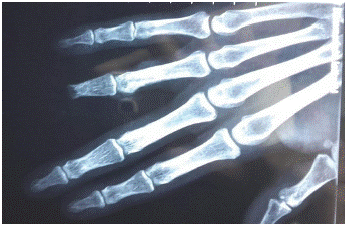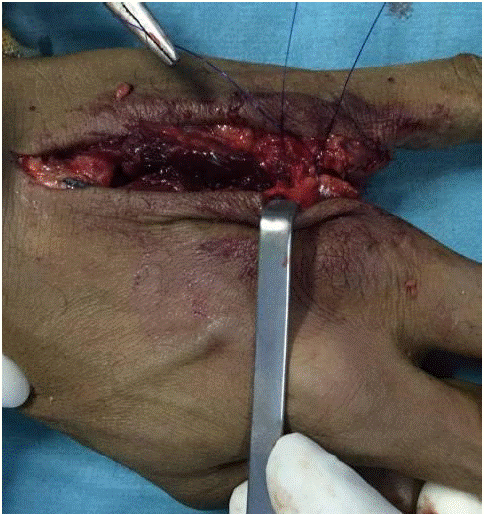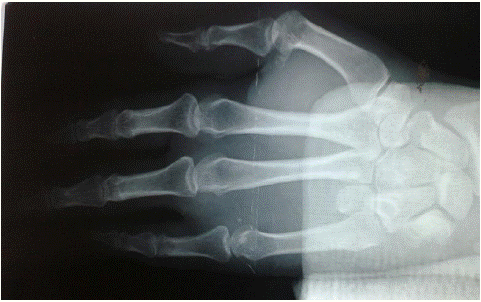
Case Report
Austin J Orthopade & Rheumatol. 2024 ; 11(1) : 1129.
Place of Basimetacarpal Amputation from The Start in Stage IV Ring Finger Lesions: Review of The Literature and Report of a Case
Badaoui R*; Ould Ghwagha O; Rachdi A; Boussaidan M; Benyass Y; Boukhriss J; Benchaba D; Chafry B
Department of Traumatologie and Orthopedic II, Military Hospital Mohammed V, Faculty of Medicine and Pharmacy of Rabat, University Mohammed V Rabat, Morocco
*Corresponding author: Badaoui R Department of Traumatologie and Orthopedic II, Military Hospital Mohammed V, Rabat, Morocco. Email: joudbadaoui17@gmail.com
Received: March 25, 2024 Accepted: April 25, 2024 Published: May 02, 2024
Abstract
The wedding ring finger is a rare lesion, which is classically considered one of the most difficult lesions for reconstructive surgery. We report a 48-year-old male case. Who was trapped in his fourth left finger by his ring in a hook when a truck was lowered. The clinical examination showed an avulsion of the fourth finger with an amputation at the level of the neck of the 2nd phalanx, classified stage IVB according to Merle-Michon. The treatment consists of a basimetacarpal amputation of the 4th ray followed by syndactylization for 6 weeks. Rehabilitation was started early. The evolution is considered satisfactory on the aesthetic and functional level, with a slight loss of the strength of the left wrist.
Keywords: Ring finger; Amputation; Basimetacarpal
Introduction
The finger of alliance or Ring Finger according to the Anglo- Saxons is a rare lesion, which is classically considered as one of the most difficult lesions for reconstructive surgery. The alliance finger-type tear-off mechanism is recognized as having a poor prognosis. Digital replanting is today an act commonly performed in SOS hand centers, but which is not far from complications.
The purpose of our case is to recall that Basimetacarpal amputation is a surgical alternative in the management of stage IV alliance fingers.
Case Presentation
The patient is a 48-year-old man, right-handed, diabetic on oral antidiabetics for 12 years. He was the victim of a trapping of his fourth left finger by his ring in a hook at the time of the descent of a truck, which led to a laceration or even disbanding of his fourth finger (Figure 1).

Figure 1: complete trapping of the 4th finger with fracture of the 2nd phalanx.
The clinical and radiological assessment showed an avulsion of the fourth finger with an amputation at the level of the neck of the 2nd phalanx (Figure 2). It was classified stage IVB according to Merle-Michon.

Figure 2: Standard radiograph shows of the neck of the 2nd phalanx of the 4th finger.
The patient was operated under locoregional anesthesia with tourniquet at the root of the upper limb. A basimetacarpal amputation of the 4th ray was made by the realization of two ways of approach, a palmar which begins by zigzag and ends in a triangle with distal base and a dorsal way in the form of V (Figure 3-4). syndactyly was maintained for 6 weeks.

Figure 3: Image showing resection of the 4th ray and suturing of the intermetacarpal ligaments III and V.

Figure 4: Image showing post-operative clinical outcome.
The mobilization of the digital segments was started early. No early complications were noted and no early surgery was required.
After 6 months follow-up, the results are considered satisfactory from an aesthetic and functional point of view, with a slight loss of strength in the left wrist (Figure 5).

Figure 5: Front hand X-Ray postoperatively.
Discussion
Since the first replanting of an avulsed finger in 1968 [1], the choice between replanting and regularization has always been debated and the management of stage IV alliance fingers is far from consensual. In the literature, some authors are in favor of first-line regularization in the event of an IVA alliance finger [2]. Many other series, on the other hand, advocate replanting. The latter can lead to a non-negligible number of complications, often causing surgical resumptions such as non-union, tendon adhesions, cold intolerance and nail dystrophy [3].
Regularization on the metacarpal basis causes few complications and is therefore surgery most often in one time. It does not require an osteotomy and there is no risk of a winding disorder or non-union due to a defect in osteosynthesis that intervention can cause, according to Leviet [4]. On the aesthetic and functional level, it gives very satisfactory results. Early and effective psychiatric care must accompany the surgical procedure to avoid the psychological consequences of such an intervention, which can compromise the end result and early resumption of activity [5].
Conclusion
Basimetacarpal regularization of stage IV alliance fingers are a reliable solution with few complications and secondary surgery. While a number of authors agree that stages IVB and IVC are indications of replanting, stage IVA is more controversial; regularization from the metacarpal base may find its place there. Replanting or basimetacarpal regularization should in any case be discussed on a case-by-case basis, with the patient.
References
- Komatsu S, Tamai S. Successful replantation of a completely cut- off thumb Plast Reconstr Surg 1968; 42: 374–7.
- Adani R, Marcoccio I, Castagnetti C, Tarallo L. Long-term results of replantation for complete ring avulsion amputations. Ann Plast Surg. 2003; 51: 564–569
- Sanmartin M, Fernandes F, Lajoie AS, Gupta A. Analysis of prognostic factors in ring avulsion injuries. J Hand Surg. 2004; 29: 1028–37.
- Leviet D. Translocation de l’auriculaire par ostéotomie intracarpienne. Ann Chir. 1978; 32: 609–12.
- Segret J, Barbary S, Pétry D, Dautel G. Alternative à la replantation dans les amputations type doigt d’alliance stade IV : amputation basimétacarpienne d’emblée. Chirurgie de la main. 2008; 27: 202–207.